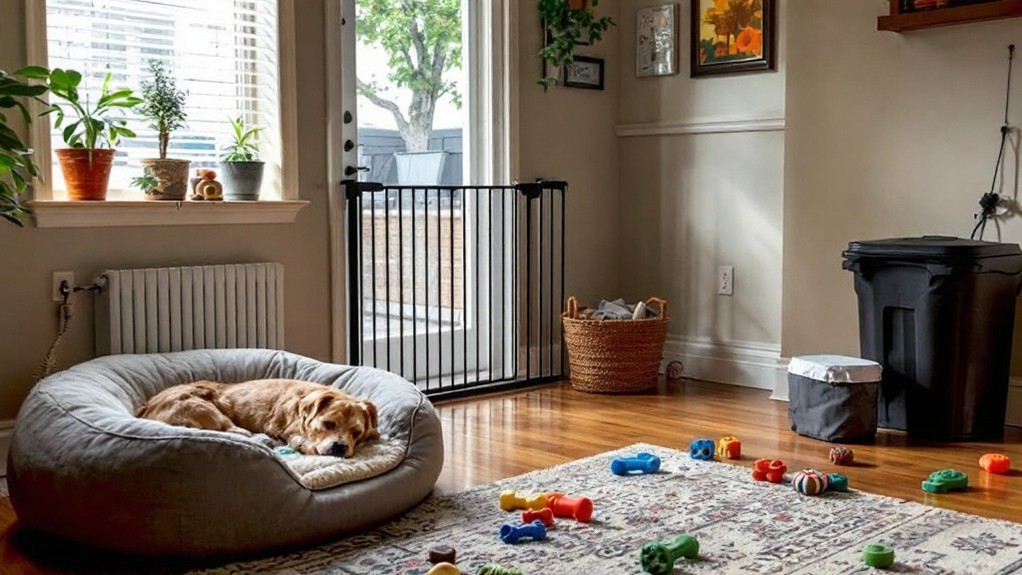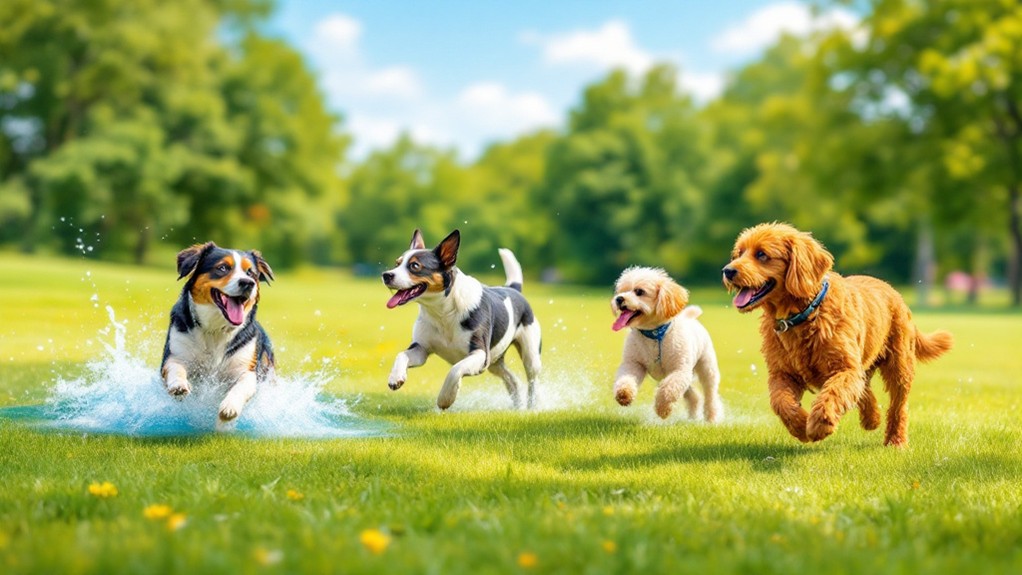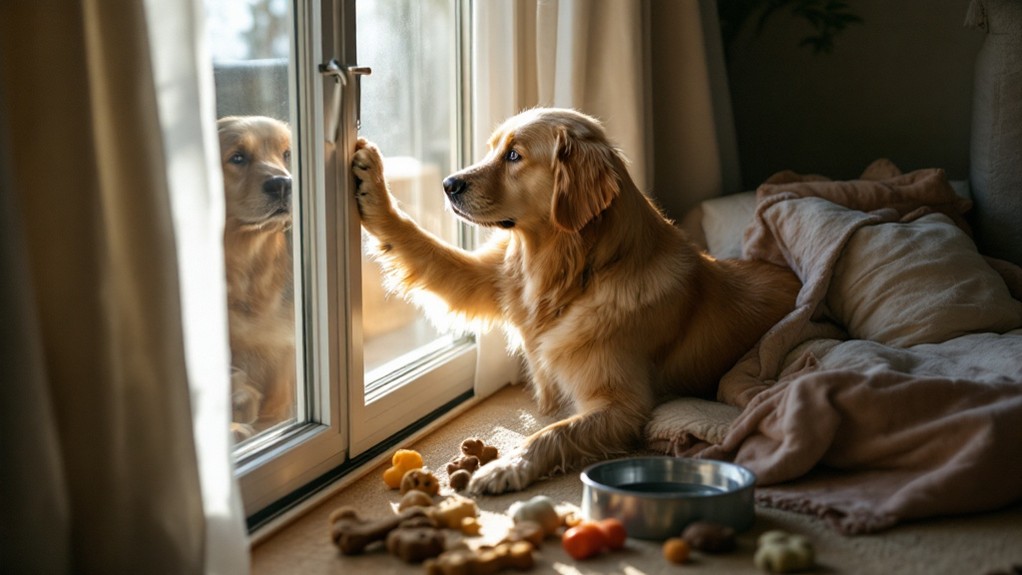Note: All blog posts on this website are 100% AI generated and has not been fact checked or edited. Do not rely on anything on this website. Instead, use it to learn about the output quality by ZimmWriter.
AIBlogPostWriter
Examples of 100% AI Written Articles by ZimmWriter
AIBlogPostWriter
Examples of 100% AI Written Articles by ZimmWriter
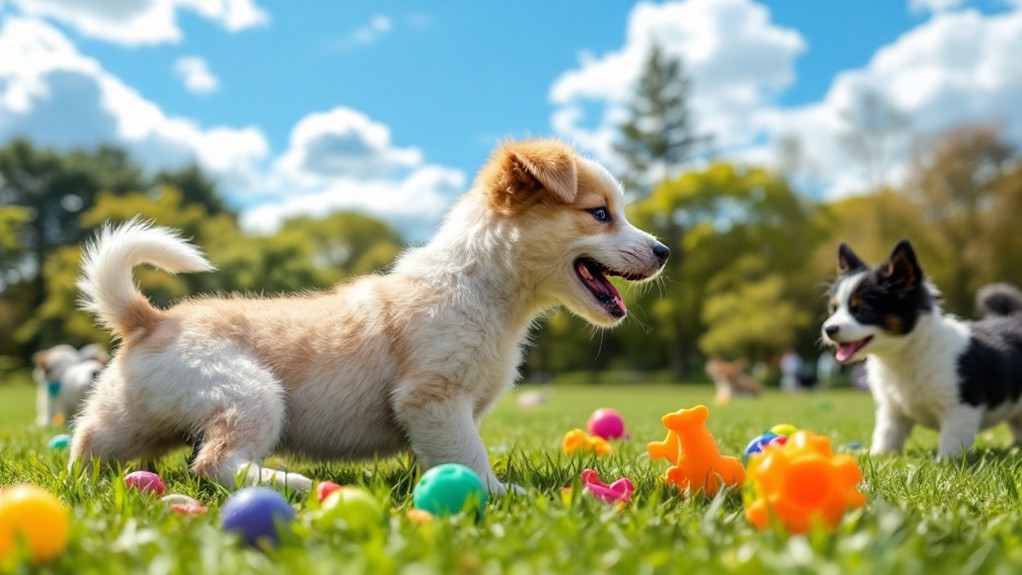
Guide to Socializing Your New Puppy Effectively
Socializing your new furry friend is essential, and it's easier than you think! Start early, ideally between 3 and 16 weeks, to shape your pup's personality. Expose your little tail-wagger to various people, animals, and environments gradually. Use treats and praise to create positive associations – your puppy's wagging tail will thank you! Short, frequent sessions are key; you don't want to overwhelm those adorable puppy eyes. Practice gentle handling and grooming to get your pup used to touch. Remember, patience is your best friend in this journey. With consistent effort and lots of love, you'll raise a confident, well-adjusted canine companion. The adventure has only just begun!
Key Takeaways
- Expose puppies to various people, animals, and environments during the critical 3-16 week period for optimal socialization.
- Use positive reinforcement with treats and praise during short, frequent socialization sessions to create enjoyable experiences.
- Gradually introduce different surfaces, sounds, and gentle handling to build confidence and prepare for future experiences.
- Supervise interactions with other animals, starting with calm adult dogs, to teach appropriate social behaviors.
- Monitor puppy's body language for signs of stress, adjusting activities as needed and celebrating progress to reinforce confidence.
Understanding Puppy Socialization
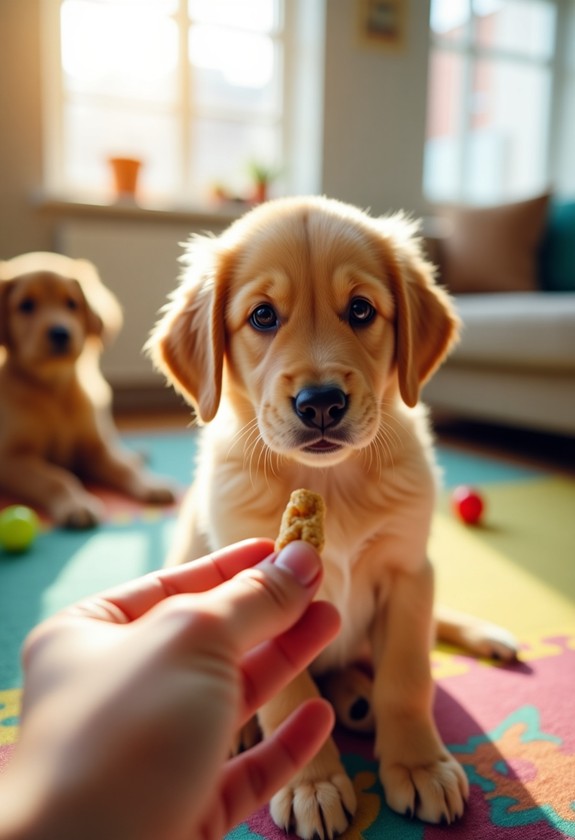
Picture a young puppy, wide-eyed and curious about the world around them. That's your new furry friend, ready to set off on a journey of discovery! Socialization is the key to raising a well-adjusted, confident canine companion. It's all about exposing your pup to a variety of experiences, people, and other animals during their critical developmental period.
You see, between 3 and 16 weeks of age, your little bundle of joy is like a sponge, soaking up everything around them. This is the perfect time to introduce them to all sorts of sights, sounds, and smells. Think of it as creating a puppy passport, stamping it with positive encounters at every turn!
Ah, but here's the catch: it's not just about quantity, it's quality too. Each interaction should be positive and stress-free. Watch for those adorable tail wags and perked ears – they're signs your pup's having a blast! And remember, patience is key. Your furry friend might be a bit hesitant at first, but with your loving guidance, they'll soon be wagging their way through life with confidence!
Critical Socialization Period
The critical socialization period for puppies spans from around 3 to 16 weeks of age. During this time, your furry little bundle of joy is like a sponge, soaking up experiences that'll shape their personality for life. It's your job to make sure those experiences are pawsitively wonderful!
Think of this period as your pup's crash course in the world. Every new sight, sound, and smell is an adventure waiting to happen. From the whoosh of a passing car to the gentle pat of a child's hand, each encounter helps your puppy build confidence and learn what's normal in their environment.
But here's the catch: you've got to act fast! Once this window closes, it becomes much harder for your four-legged friend to adapt to new situations. So, grab your calendar and start planning puppy playdates, neighborhood walks, and trips to the park. Remember, variety is key. Introduce your pup to different people, animals, and environments. And don't forget, treats and praise are your secret weapons in making these experiences tail-waggingly good!
Positive Exposure Techniques
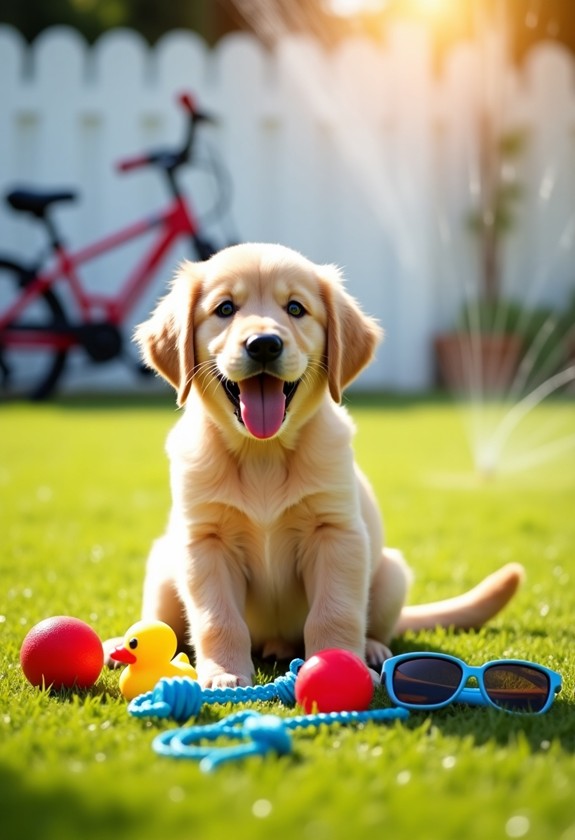
When it comes to positive exposure techniques, you'll want to ease your puppy into new experiences gradually. Start with calm, controlled environments and work your way up to more stimulating situations. Your furry friend's tail might be wagging with excitement, but remember, slow and steady wins the race!
Begin by introducing your pup to various surfaces – grass, carpet, tile – you name it! Watch as those tiny paws explore each texture with curiosity. Next, expose your little bundle of joy to different sounds. From gentle whispers to the vacuum cleaner's roar, let your puppy's ears perk up and swivel adorably.
Oh, and don't forget about people! Invite friends over, but remind them to approach your pup calmly. Your puppy's eyes will widen with wonder as they meet new faces. Finally, introduce other animals gradually. Picture your pup's nose twitching with interest as they encounter a friendly cat or another well-behaved dog. Remember, praise and treats go a long way in making these experiences positive. Before you know it, your once-timid puppy will be a social butterfly, ready to take on the world with a wagging tail and a happy bark!
Handling and Touch Desensitization
Getting your puppy comfortable with being touched and handled is essential for their long-term well-being. Start by gently petting your furry friend all over their body, paying special attention to their paws, ears, and mouth. Oh, those wiggly little toes and floppy ears! As you touch them, offer praise and treats to create positive associations. Remember, patience is key – your pup might be a bit squirmy at first!
Next, introduce your puppy to grooming tools. Let them sniff and investigate the brush, nail clippers, and toothbrush before using them. Slowly work up to short grooming sessions, always keeping things fun and rewarding. You might find yourself covered in fur, but it's worth it!
Don't forget about those adorable puppy teeth! Gently lift their lips and touch their teeth and gums. This will make future vet visits and dental care much easier. And speaking of vets, practice "mock exams" at home. Pretend to check their eyes, ears, and tummy – your little patient might even enjoy the extra attention! With time and consistency, your pup will become a pro at being handled, making life easier for everyone involved.
Environmental Socialization
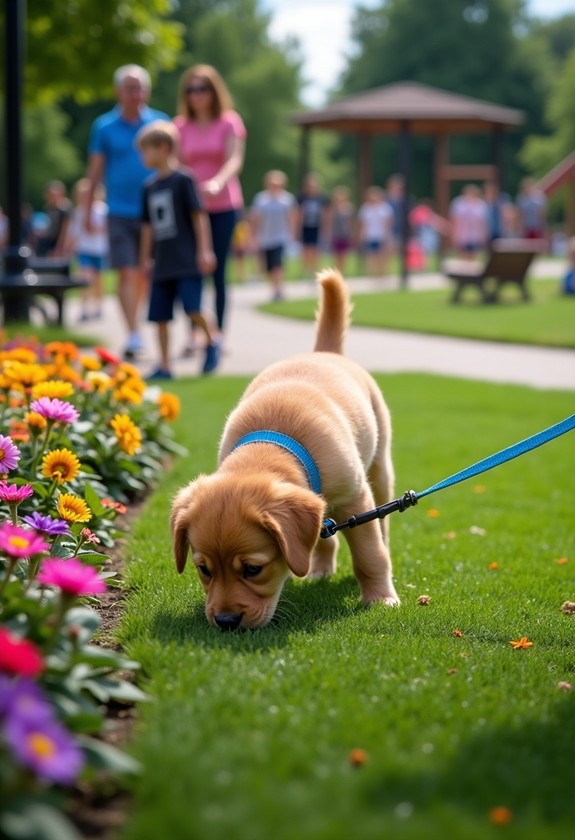
Now that your puppy is comfortable being handled, it's time to introduce them to the big, wide world! Environmental socialization is essential for raising a well-adjusted, confident dog. Your furry friend needs to experience a variety of sights, sounds, and smells to become a brave little explorer.
Start by taking your pup on short adventures around your neighborhood. Oh, the excitement in those tiny paws as they discover new terrain! Watch their little nose twitch with curiosity at every lamppost and fire hydrant. Gradually expose them to different environments, like parks, busy streets, and even cafes (if they allow dogs, of course).
Remember, socialization isn't just about places. It's also about experiences. Here are three key areas to focus on:
- Surfaces: Let them feel grass, gravel, and tile under their paws.
- Sounds: Introduce them to vacuum cleaners, doorbells, and even fireworks (recordings at first).
- Moving objects: Bicycles, skateboards, and cars can be scary!
Always keep these outings positive and fun. If your pup seems overwhelmed, take a step back and try again later. With patience and lots of treats, you'll soon have a socialization superstar!
Socialization With Other Animals
Introducing your puppy to other animals is an essential part of their socialization journey. Oh, the excitement and tail-wagging chaos that ensues! Your furry little bundle of joy needs to learn how to play nice with their fellow four-legged friends. Start small, introducing your pup to calm, well-behaved adult dogs. Watch as they sniff, circle, and maybe even let out a tiny, squeaky bark. It's adorable!
Next up, cats! Now, this can be a bit trickier. Your pup might think the cat's tail is the world's most fantastic toy. Supervise closely, and don't be surprised if your kitten delivers a swift swat to teach your overeager puppy some manners. Ouch! But don't worry, they'll figure it out.
For the brave and adventurous, consider introducing your pup to farm animals. Imagine your little fluffball's bewildered face when they meet a cow for the first time! Just be prepared for some comical reactions and maybe a bit of nervous peeing. Remember, patience is key. With time and positive experiences, your puppy will become a social butterfly in the animal kingdom.
Overcoming Fear and Anxiety
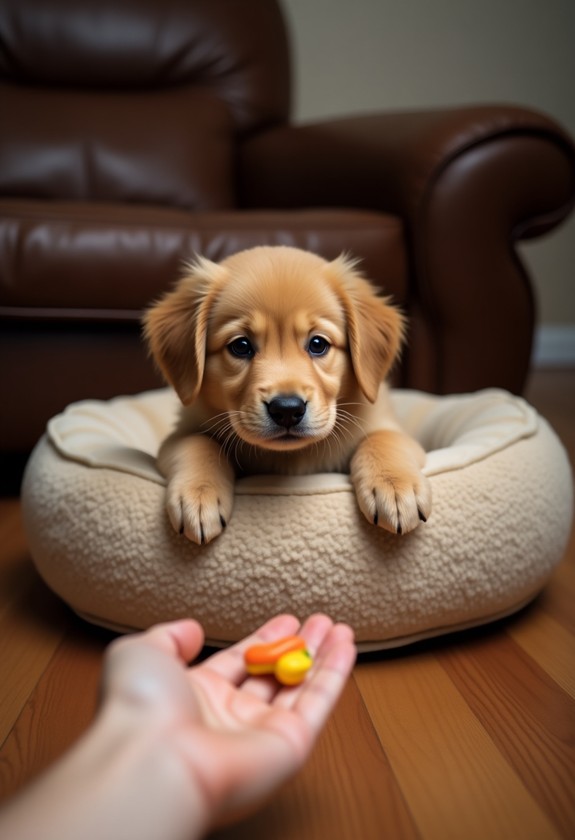
Courage is key when helping your puppy overcome fear and anxiety during socialization. Your furry friend might tremble at new sights, sounds, or experiences, but don't worry! With patience and love, you'll guide them through this vital stage.
First, identify your pup's triggers. Is it the vacuum cleaner's roar or the neighbor's friendly but booming voice? Once you know, you can tackle these fears step by step. Remember, slow and steady wins the race!
Here's a simple approach to help your little ball of fluff:
- Start with distance: Introduce the scary thing from afar
- Use treats liberally: Associate good things with the feared object
- Gradually decrease distance: Move closer as your pup relaxes
Oh, the joy of seeing your once-timid pooch bravely approach what used to terrify them! It's like watching a tiny, furry superhero emerge. Stay calm and reassuring throughout the process. Your pup takes cues from you, so if you're relaxed, they're more likely to follow suit.
Celebrate small victories, and before you know it, your brave little companion will be wagging their tail at the world!
Frequently Asked Questions
How Do I Socialize My Puppy if I Live in a Rural Area?
Oh, you rural pup parents, don't fret! You've got this socialization thing. Start by inviting friends and family over for puppy playdates. Your little fur-ball will love the attention! Take trips to nearby towns, letting your pup experience new sights and sounds. Visit pet-friendly stores, where your curious canine can sniff out adventure. And don't forget, nature's your playground! Expose your pup to different terrains, animals, and weather conditions. With creativity and love, you'll raise a well-rounded, tail-wagging country dog!
Can Over-Socialization Be Harmful to My Puppy's Development?
Whoa, hold your horses, puppy parent! Yes, over-socialization can be a real bummer for your furry friend. Too much excitement can overwhelm your pup, leading to anxiety or fear. It's like throwing a shy kid into a mosh pit! You'll want to introduce new experiences gradually, watching for signs of stress. If your pup's tail is tucked or they're cowering, take a step back. Remember, quality over quantity! Gentle, positive encounters will help your little buddy grow into a confident, well-adjusted pooch.
Should I Continue Socialization Efforts After My Puppy's Vaccinations Are Complete?
Absolutely, you should! Socialization isn't just a puppy phase, it's a lifelong journey for your furry friend. Even after those pesky shots are done, keep exposing your pup to new experiences. Oh, the adventures you'll have! From meeting friendly faces to exploring exciting places, your four-legged companion will grow more confident and well-adjusted. Remember, a socialized dog is a happy dog. So, keep up the good work, and watch your pup blossom into a social butterfly – or should we say, social "pupper-fly"?
How Do I Balance Socialization With My Puppy's Need for Rest?
You might worry that socializing your pup means non-stop action, but don't fret! Balance is key, dear pet parent. Your furry friend needs beauty sleep too! Watch for those adorable yawns and droopy eyes. When Fido starts resembling a fuzzy, four-legged zombie, it's nap time. Alternate short, fun socializing sessions with cozy rest periods. Remember, a well-rested pup is a happy learner. Plus, those puppy snores are the cutest soundtrack for your day!
What Are Signs That My Puppy Is Becoming Stressed During Socialization Activities?
Oh, those little furry stress balls! Your pup might be telling you, "Whoa, this is too much!" Watch for these signs: tucked tail, flattened ears, excessive yawning or lip-licking. Is your little buddy cowering or trying to hide? That's a big red flag! If Fido's suddenly become a panting machine or is shaking like a leaf, it's time for a break. Remember, socialization should be fun, not frightening. Your puppy's comfort is key, so keep those eyes peeled and be ready to swoop in!
